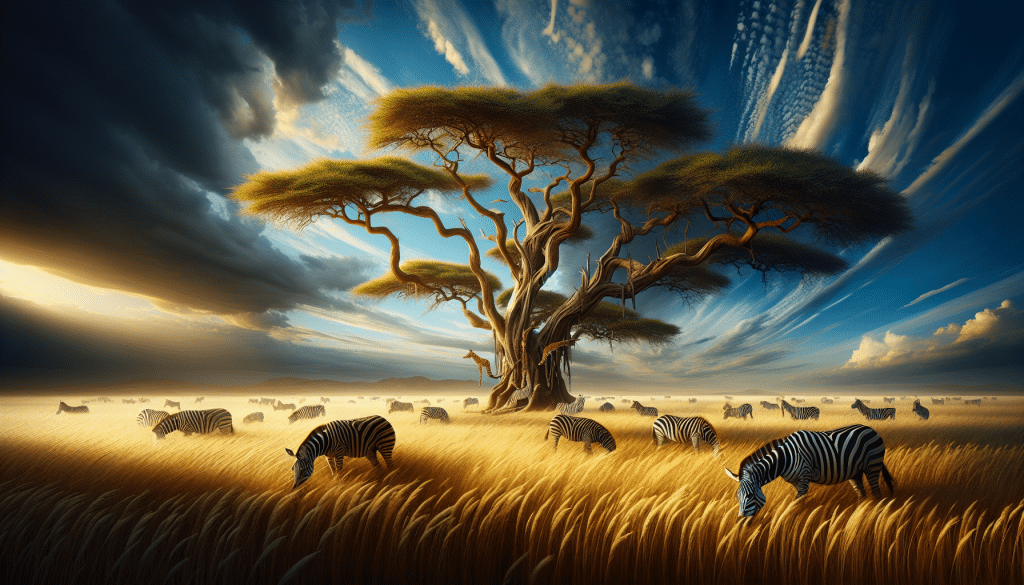Listen up, you! Prepare to be astounded as you delve into the captivating world of the zebra habitat. Brace yourself for a wild ride as we unravel the secrets of these fascinating creatures and their unique surroundings. From the vast plains of Africa to the tangled depths of the savannah, the zebra habitat is an untamed realm like no other. Hold on tight, because you’re about to uncover the untold wonders that exist within the chaotic dance of stripes and shadows.

Understanding Zebra Species and Their Distribution
Overview of Different Zebra Species
Zebras are fascinating creatures that belong to the equine family and are known for their distinctive black and white stripes. There are three main species of zebras: the plains zebra (Equus quagga), the mountain zebra (Equus zebra), and the Grevy’s zebra (Equus grevyi). Each species has its own unique characteristics and can be found in different regions of Africa.
The plains zebra is the most widespread and abundant species, inhabiting grasslands and savannas across eastern and southern Africa. It is characterized by its bold black and white striping pattern, which is regarded as a visual deterrent to predators. The mountain zebra, as the name suggests, is found in more mountainous regions, primarily in Namibia and South Africa. It has a more limited distribution and is known for its broader stripes and stocky build. The Grevy’s zebra, on the other hand, is the largest and most endangered of the zebra species. It is native to the arid grasslands of Ethiopia and northern Kenya.
Geographical Distribution of Zebras
Zebras have a varied distribution across Africa, ranging from the savannas of East Africa to the rugged mountains of the south. The plains zebra can be found in countries such as Kenya, Tanzania, Botswana, and South Africa. Mountain zebras are primarily distributed in Namibia and South Africa, specifically in the mountainous regions of the Namaqualand and Karoo. Grevy’s zebras are confined to the arid grasslands of Ethiopia and northern Kenya.
Zebra Migration Patterns
Migration is an important behavior observed in some populations of zebras. The plains zebra, in particular, is known for its impressive migratory movements. One example is the annual migration of hundreds of thousands of zebras in the Serengeti-Mara ecosystem. These zebras undertake a long-distance journey, following the seasonal availability of water and grazing resources. Similarly, some populations of mountain zebras are also known to undertake seasonal migrations in search of food and water. These migration patterns are of great ecological significance as they help distribute herbivore pressure and influence the ecosystems they inhabit.
Characteristics of Zebra Habitats
General Features of Zebra Habitats
Zebras are well-adapted to a variety of habitats, ranging from grasslands to mountains and semi-arid regions. They prefer open areas with access to water sources and abundant vegetation. Zebras have evolved to thrive in diverse landscapes, utilizing their mobility and social behavior to navigate their habitats efficiently.
Grasslands and Savannas: The Primary Zebra Environment
The grasslands and savannas of Africa are the primary habitats for zebras. These open landscapes provide them with ample grazing opportunities and suitable conditions for social interaction. Zebras have a diet primarily composed of grass, so the presence of vast grassy plains is crucial for their survival. These habitats also offer good visibility, allowing zebras to spot predators in the distance and form defensive herds.
Water Sources and Their Importance to Zebras
Access to water is essential for the survival of zebras. These animals require regular drinking intervals and are highly dependent on water sources in their habitats. During the dry season, when water becomes scarce, zebras may travel long distances in search of water. The availability of water influences zebra distribution and can impact their migratory patterns.

The Role of Climate in Zebra Habitats
Understanding the Impact of Seasonal Changes
Climate plays a significant role in shaping zebra habitats and behaviors. Seasonal changes, such as rainfall patterns and temperature fluctuations, have a direct impact on the distribution of vegetation and the availability of resources. Zebras have adapted to these seasonal changes by migrating or adjusting their foraging behaviors accordingly.
Drought and Its Effects on Zebra Populations
Droughts can pose a serious threat to zebra populations. During periods of prolonged drought, water sources may dry up, leading to competition among different animal species for limited resources. Zebras may be forced to travel longer distances in search of water and may experience increased stress and reduced reproductive success during drought conditions.
Adaptations of Zebras to Various Climate Conditions
Zebras have developed remarkable adaptations to cope with a range of climatic conditions. Their black and white stripes, for example, are believed to play a role in temperature regulation. The dark stripes absorb heat, while the lighter stripes reflect sunlight, helping zebras regulate their body temperature in hot environments. Additionally, their ability to migrate and adjust their feeding habits allows them to survive in different climatic regions.
Human Influence on Zebra Habitats
Habitat Fragmentation and Loss Due to Agriculture
Human activities, particularly agriculture and urbanization, have led to habitat fragmentation and loss for zebras. As human populations grow and agricultural practices expand, natural habitats are converted into farmland or infrastructure. This encroachment on zebra habitats disrupts their natural movements, reduces available grazing areas, and increases the risk of human-wildlife conflict.
Conservation Efforts to Protect Zebra Habitats
Conservation organizations and governments are implementing various initiatives to protect zebra habitats. Efforts include the establishment of protected areas, such as national parks and reserves, where zebras and other wildlife can thrive undisturbed. These conservation measures aim to preserve the biodiversity and ecological balance of zebra habitats.
The Impact of Ecotourism
Ecotourism has emerged as a potential solution to support zebra habitat conservation. Responsible tourism practices can generate revenue that can be used to fund conservation projects and incentivize local communities to protect their natural heritage. Well-managed ecotourism can help raise awareness about zebras and contribute to the sustainable development of local communities.

Threats to Zebra Habitats
Poaching and Its Consequences
Poaching poses a grave threat to zebras, especially Grevy’s zebras, due to the high value of their skin and body parts in illegal wildlife trade. The illegal hunting of zebras not only harms their populations but also disrupts the ecological balance of their habitats. Conservation efforts must focus on curbing poaching activities and enforcing strict penalties for offenders.
Invasive Species and Habitat Competition
Invasive species can have a detrimental impact on zebra habitats. These non-native species often outcompete native vegetation, reducing suitable grazing areas for zebras. Additionally, invasive predators can disrupt natural predator-prey dynamics and pose a threat to zebra populations. Effective management strategies are necessary to control invasive species and mitigate their impact on zebra habitats.
Diseases Affecting Zebras in the Wild
Diseases can have devastating effects on zebra populations in the wild. Outbreaks of infectious diseases, such as anthrax and equine influenza, can lead to mass mortality events that severely impact zebra populations and disrupt their habitats. Monitoring and disease management programs are crucial to ensure the health and survival of zebras in their natural habitats.
Zebra Interaction with Other Wildlife
Predator-Prey Relationships in Zebra Habitats
Zebras are an important prey species in their habitats and play a vital role in sustaining predator populations. Predators such as lions, hyenas, and leopards rely on zebras as a source of food. These interactions contribute to the overall balance and functioning of the ecosystem.
Symbiotic Relationships and Mutualism
Zebras also form symbiotic relationships with other wildlife species. They often graze alongside other herbivores, such as wildebeests and giraffes, benefiting from their collective vigilance against predators. This mutualistic relationship ensures increased security for all species involved.
Competition Among Grazing Species
Competition for limited resources, such as grazing areas, can arise among different herbivore species within zebra habitats. Zebras must compete with other grazers, such as antelopes and buffalo, for access to prime feeding grounds. This competition shapes zebra foraging patterns and influences their distribution within the habitat.
Zebra Social Structure and Habitat
Herd Dynamics within the Habitat
Zebras exhibit a complex social structure and live in herds composed of multiple individuals. These herds are organized hierarchically, with dominant individuals leading the group and maintaining social order. This social structure allows for collective defense against predators and facilitates communication within the herd.
Territory and Home Range of Different Zebra Herds
Zebras have defined territories within their habitats, which they defend against rival groups. These territories provide access to important resources, such as water and grazing areas. The size of the territory and home range can vary depending on the population density and availability of resources in the habitat.
The Role of Mares and Foals in Zebra Society
Mares play a crucial role in zebra society, as they are responsible for the care and protection of foals. Female zebras form strong bonds with their offspring, ensuring their survival and teaching them essential skills for life in the habitat. Foals learn behaviors such as foraging, evasion techniques, and social interaction from their mothers.
The Daily Life of Zebras in Their Habitat
Foraging Patterns and Diet
Zebras are grazers, feeding primarily on grass and occasionally browsing on tree leaves and shrubs. Their foraging patterns depend on the availability and quality of vegetation in their habitats. Zebras have adapted to efficiently extract nutrients from grasses, utilizing their specialized teeth and digestive system.
Watering Behaviors and Rituals
Water is a vital resource for zebras, and their watering behaviors are of great importance. Zebras have specific rituals associated with drinking, often approaching water sources cautiously to ensure safety from predators. They may also engage in social interactions and grooming while drinking, reinforcing social bonds within the herd.
Resting and Vigilance in Open Plain Areas
In open plain areas, zebras must remain vigilant at all times to detect potential predators. They employ a resting and grazing rotation strategy, where members of the herd take turns resting while others remain vigilant for signs of danger. This collective vigilance ensures the survival of the group and reduces individual vulnerability.
Reproductive Behavior and Habitat
Breeding Season and Environmental Triggers
Zebras have specific breeding seasons that are often triggered by environmental cues such as rainfall patterns and the availability of food resources. Breeding behavior is influenced by these environmental factors, ensuring that foals are born during periods of favorable conditions.
Birthing Areas and Foal Rearing
Zebras select specific areas within their habitats for birthing, usually choosing sheltered locations with access to water and adequate forage. After birth, foals are cared for by their mothers and are introduced to the social dynamics of the herd. Foals learn important life skills from their mothers and gradually integrate into the social structure of the zebra group.
The Role of Habitat in Survivorship of Young Zebras
The habitat plays a crucial role in the survivorship of young zebras. Adequate vegetation and water availability are critical for the growth and development of foals. Additionally, the presence of suitable shelter and protection from predators ensures the safety and survival of the young zebras.
Future of Zebra Habitats
Predicted Changes Due to Global Warming
Global warming and climate change pose significant challenges to zebra habitats in the future. Rising temperatures, shifts in rainfall patterns, and increased frequency of extreme weather events can disrupt the natural dynamics of these habitats. Zebras will need to adapt to these changes or face further habitat loss and population decline.
Role of Protected Areas and Reserves
Protected areas and reserves have a vital role to play in safeguarding zebra habitats. These designated areas provide a sanctuary for zebras and other wildlife, allowing them to thrive undisturbed by human activities. The conservation and expansion of protected areas are crucial for maintaining biodiversity and preserving the unique ecosystems that zebras and other species rely on.
Community Involvement in Habitat Conservation
Community involvement and engagement are essential for the long-term conservation of zebra habitats. Local communities living in or near zebra habitats can play a significant role in monitoring and protecting these areas. By raising awareness, providing sustainable livelihood opportunities, and involving communities in decision-making processes, habitat conservation efforts can be more effective and sustainable in the long run.
In conclusion, understanding zebra species and their distribution is crucial for their conservation and the preservation of their unique habitats. The characteristics of zebra habitats, the role of climate, human influence, threats, and their interactions with other wildlife all shape the complex dynamics of these habitats. By recognizing the importance of zebra habitats and implementing effective conservation strategies, we can ensure the long-term survival of these majestic animals in their natural environments.



